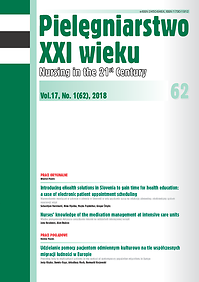Assesment of nurses knowledge about non – Hodgkin’s lymphomas
DOI:
https://doi.org/10.2478/pielxxiw-2018-0004Keywords:
lymphoma, evaluation, knowledge, nurseAbstract
ASSESMENT OF NURSES KNOWLEDGE ABOUT NON – HODGKIN’S LYMPHOMAS
Introduction. Non-Hodgkin lymphomas (NHL) are among the most frequent types of cancer linked with the lymphatic system. The disease, if not diagnosed or treated, may lead to serious health complications and/or death.
Aim. The purpose of the work is to evaluate the level of knowledge of nursing staff about NHL.
Material and methods. There were 100 members of nursing staff aged from 24 to 56 participating in the study. The research method was a diagnostic survey but the measuring tool was an anonymous author’s questionnaire which comprised 25 closed, single-choice questions and 2 filtering questions.
Results. Among the respondents, 48% work at the Clinical Haematology/Oncology Ward, while the remaining 52% work in other wards. The question: “Is it possible for the NHL to be located outside the lymphatic system?”, 55% of respondents responded with an affirmative, 23% with a negative, 22% did not know the answer. Among the respondents, 100% stated that their employers do not designate any financial assets to train medical personnel with respect to expanding their knowledge about non-Hodgkin lymphomas. As many as 46% of respondents expand their knowledge through self-study using their own means. According to the National Cancer Registry, in 2014 there were 874 incidents and 236 deaths noted among men and 862 incidents and 235 deaths among women, linked with the diffused NHL. Comparing the data of the National Cancer Registry with the previous years, we can observe an increasing trend of morbidity and mortality, linked with the NHL. For example, in 2006 there were a total 1207 cases and 315 deaths linked with the dif used NHL.
Conclusions. Results show that the respondents’ awareness with regard to NHL is limited. Employers do not finance NHL training, which may affect the low level of knowledge. NHL patient hospitalization is a long-term process requiring expenses and effort on the side of medical personnel. Nursing and health education are necessary elements of the therapeutic process of an NHL patient.
References
1. Kułakowski A, Skowrońska-Gardas A (red.). Onkologia. Podręcznik dla studentów medycyny. Warszawa: Wydawnictwo Lekarskie PZWL; 2003, s. 205-214.
2. Smolewski P. Standardy leczenia chłoniaków nieziarniczych B-komórkowych. Acta Haematol Pol. 2010; 41; 325 – 334.
3. Dostęp z: http://onkologia.org.pl/raporty/, w dniu 28.12.2017.
4. Gajewski P, Szczeklik A (red.) Interna. Podręcznik chorób wewnętrznych. Kraków: Wydawnictwo Medycyna Praktyczna; 2013, s. 1699-1713.
5. Dostęp z: http://www.ihit.waw.pl/Czynniki-ryzyka-i-przyczyny-chloniakow-niezierniczych.html, w dniu 24.03.2015.
6. Sawczuk–Chabin J, Centkowski P, Biliński P i in. Epidemiologia nieziarniczych chłoniaków złośliwych. Acta Haematol Pol. 2004; 35: 131-144.
7. Lech-Merańda E, Warzocha K. Diagnostyka i leczenia chłoniaków nieziarniczych. Postępy Nauk Medycznych. 2011; 7: 567-576.
8. Kordek R (red.) Jassem J, Jeziorski A i in. Onkologia. Podręcznik dla studentów i lekarzy. Gdańsk: Wydawnictwo Via Medica; 2013, s. 279-285.
9. Gotlib J, Belowska J, Panczyk M i wsp. Wiedza i postawy pielęgniarek wobec wykorzystywania wyników badań naukowych w codziennej praktyce klinicznej – doniesienie wstępne. Probl Piel. 2014; 22: 281-287.
10. Moczydłowska A, Krajewska-Kułak E, Kózka M i wsp. Oczekiwania chorych wobec personelu medycznego. Probl Piel. 2014; 22: 464-470.
11. Dostęp z: http://www.przebisnieg.org/aktualnosci/328-co-polacy-wiedza-o-chloniakach, w dniu 13.05.2015.
Published
Issue
Section
License
Copyright (c) 2018 Authors

This work is licensed under a Creative Commons Attribution-NonCommercial-NoDerivatives 3.0 Unported License.




